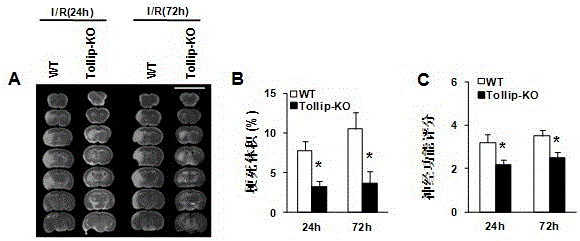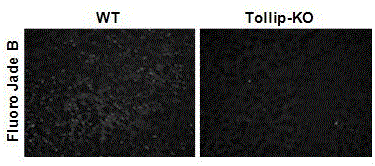Application of toll-acting protein (tollip) in stroke
A stroke and disease technology, applied in the field of application of Toll-acting protein (Tollip) in stroke diseases, to achieve the effect of reducing infarct volume and deteriorating neurological function
- Summary
- Abstract
- Description
- Claims
- Application Information
AI Technical Summary
Problems solved by technology
Method used
Image
Examples
Embodiment 1
[0027] [Example 1] Mouse cerebral infarction model (I / R) was obtained
[0028] 1. Experimental animal grouping: male C57BL / 6 strain wild-type mice and Tollip gene knockout mice were used to establish cerebral infarction models (I / R) through middle cerebral artery ischemia-reperfusion. Randomly divided into 2 groups, each with 10 mice: C57BL / 6 strain wild-type mouse I / R group (WT I / R), Tollip gene knockout mouse I / R group (KO I / R) .
[0029] 2. The operation procedure of the MCAO (middle cerebral artery occlusion) model used in the I / R operation of thread embolization cerebral infarction:
[0030] (1) Grab the mouse, use 3% isoflurane to anesthetize the mouse, remove the rat hair from the neck with 8% sodium sulfide, cut off the rat hair quickly with surgical scissors, and sterilize the neck and skull with 3% vigor iodine Top skin 2 times, 75% alcohol deiodine 1 time;
[0031] (2) Make a lateral incision on the top of the mouse's skull to expose the skull, and gently peel off the con...
Embodiment 2
[0035] [Example 2] Measurement of cerebral infarct volume in cerebral infarction model (I / R) mice
[0036] The evaluation indicators of the severity of cerebral ischemia / reperfusion injury mainly include cerebral infarction volume and neurological function score, which are all positively correlated with the severity of ischemia / reperfusion injury.
[0037] (1) Perform neurological function and behavioral scores at 24h and 72h after surgery, respectively;
[0038] Based on Berderson neurological function score improvement method (9-point scale):
[0039] 0 points: no symptoms of nerve damage;
[0040] 1 point: The contralateral forelimb is curled up when the tail is lifted, or cannot reach the affected forelimb completely;
[0041] 2 points: Adduction of the opposite shoulder when lifting the tail;
[0042] 3 points: flat push: resistance drops when pushing to the opposite side;
[0043] 4 points: Can move spontaneously in all directions, but only turn to the opposite side when taking off t...
Embodiment 3
[0057] [Example 3] Determination of neuronal cell apoptosis in the peripheral area of cerebral infarction
[0058] 1. Preparation of frozen sections of brain tissue
[0059] 1) Experimental mice are anesthetized by intraperitoneal injection of sodium pentobarbital at a dose of 50 mg / kg;
[0060] 2) Open the chest to expose the heart, puncture the left ventricle with an injection needle, and cut the right atrium at the same time;
[0061] 3) After perfusion with 0.1mol / L PBS (pH7.4) 100mmHg until the liver becomes pale, perfusion with 4% paraformaldehyde for 15min;
[0062] 4) Take out the mouse brain quickly after craniotomy, and fix it for 6-8h after 4% paraformaldehyde at room temperature;
[0063] 5) Remove the olfactory bulb and cerebellum of the brain tissue, then divide the brain into two parts one after another along the median line, and fix it with the previous fixative for another 15 minutes;
[0064] 6) Submerge it in a phosphate buffer containing 30% sucrose and sink in a re...
PUM
 Login to View More
Login to View More Abstract
Description
Claims
Application Information
 Login to View More
Login to View More - R&D
- Intellectual Property
- Life Sciences
- Materials
- Tech Scout
- Unparalleled Data Quality
- Higher Quality Content
- 60% Fewer Hallucinations
Browse by: Latest US Patents, China's latest patents, Technical Efficacy Thesaurus, Application Domain, Technology Topic, Popular Technical Reports.
© 2025 PatSnap. All rights reserved.Legal|Privacy policy|Modern Slavery Act Transparency Statement|Sitemap|About US| Contact US: help@patsnap.com


